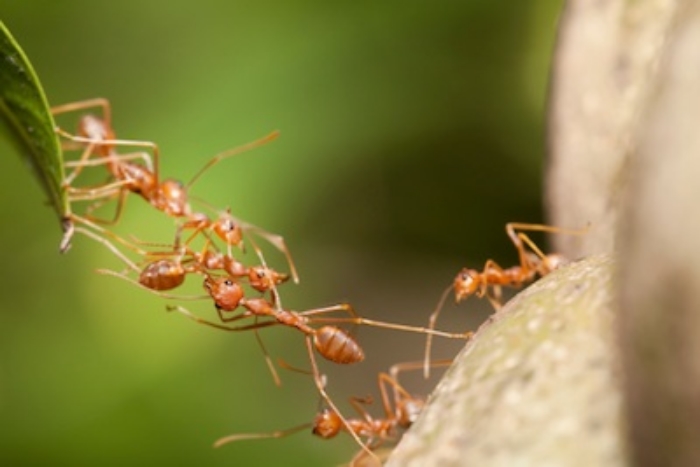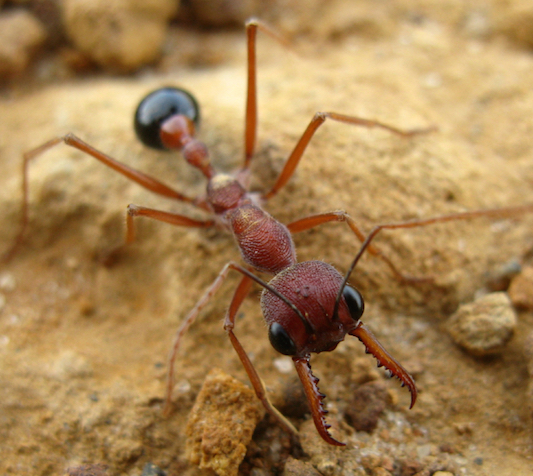Ants are tiny insects.
There are lots of different kinds of ants.
Ants live in big groups.
They work together like a team.
Ants can carry things much bigger than themselves.
Ants have lived on the Earth for more than 100 million years and can be found almost everywhere on the planet.
An Ant's Body
Ants are insects, and like all insects, have a body with three main parts - the head, the thorax (middle section), and the abdomen.
The abdomen of an ant is narrow where it joins onto the thorax. Insects have six legs that are attached to the thorax, three to each side.
The head is made up of the jaws called mandibles, the eyes, and the antennae. The eyes of ants are made up of many lenses and are called compound eyes. Compound eyes make it possible for ants to see movement very well.
The antennae are special organs used by the ant to smell, touch, taste, and hear.
In the abdomen are the ant's stomach and rectum. Many species (kinds) of ants have poison sacks and/or stingers in the end of the abdomen for defence against predators (enemies). Ants breathe through tiny holes all over their body. The ant's heart is a long tube that pumps colourless blood from the head back to the abdomen and then back up to the head again.
Illustration of the inside of an ant nest. See the queen in her chamber. ©Getty Images
Ant Colonies
Ants live in large colonies or groups. Their home is a nest. There may be up to a million ants in a large nest. In each colony there are three types of ants: the queen, the female workers, and males.
The only job of male ants is to mate with a queen ants so that she will be able to lay eggs, which is her only task. Male ants don't live very long.
The queen grows to be an adult, mates with a male, then spends the rest of her life laying eggs. In a colony there may be only one queen or there may be many queens, depending on the species of ant.
Worker ants do all the work in the nest. They build it and clean it, gather food, look after the queen, the eggs, and the young ants. Worker ants also defend the nest.
Nests
Different kinds of ants build different types of nests.
Some build simple mounds of dirt or sand. Others use small sticks mixed with dirt and sand to make stronger, waterproof mounds.
Inside the nest there are many chambers (or rooms). The chambers are connected to each other by tunnels. Chambers are used for different things, for example as nurseries for eggs and young ants, for storing food, as resting places for the worker ants and a there's a special chamber just for the queen.
Ants communicate (talk to each other) by touching each other with their antennae. They also use chemicals called pheromones (say feh-ruh-moans) to leave a trail of scent for other ants to follow.
Life cycle
Ants moving a larva. ©Getty Images
Leaf cutter ants have large jaws ©Getty Images
Leaf cutter ants
Leaf cutter ants live in South and Central America, and in the southwestern part of the USA. They climb tall trees and cut small pieces of leaves which they carry back to their nest. Some of the worker ants have large jaws that vibrate very fast and operate like power saws.
The leaf pieces they carry are about 50 times their weight. Other workers are gardeners, and bury the leaf pieces in the ground, and the combination of the leaves and the ants' saliva encourages the growth of a fungus. Without the ants, the fungus would not grow, and the fungus is the only food that the leaf cutter ants eat.
Watch a video of Leaf cutter ants
Army ants
Ants forming a bridge so other workers can cross a gap. ©Getty images
Army ants are found in South and Central America. They are carnivorous. They don't make a permanent nest, only temporary shelters as they keep on the move in huge swarms, travelling at up to 20 metres an hour. Their movement is in waves of specific times: the colony stays in one place for a 20 day period, during which time the queen lays about 100,000 eggs, which hatch and larvae pupate. Then the colony is on the move again for about 15 days. A swarm of army ants can be about 100 m long.
Armed with large mandibles (jaws), they attack whatever comes across their path, cutting it up and spraying it with a special saliva that dissolves it into easily digested liquid. Their team work is excellent, and when there are gaps to cross, some ants join together to make a bridge for the others to cross. Together, they carry large loads. Army ants are a very important part of the rainforest environment because several hundred animal species depend on them in some way, and birds dig up the rainforest ground searching for the ant nests to feed on them.
Bull ants can give a painful sting © Getty images
Bull ants
Bull ants are large ants, up to 40mm long. Native to Australia, there are about 90 different kinds of bull ant, and possibly more yet to be discovered. They live in forests and woodlands, but also in some areas where people live. Bull ants have long mandibles and a painful poisonous sting. They nest underground, often with hidden entrances. Their eyesight is excellent, and they attack any predator that comes too close to the nest. Bull ants collect nectar as well as small animal prey and carry it back to the nest.
Honeypot ants
Honeypot ant ©Getty Images
Honeypot ants are found in central Australia.
They make nests in the sandy soil under trees or bushes, with an entrance hidden by the leaf litter. They harvest honeydew, which is produced by aphids from the sap they feed on. The ants use their antennae to get the aphids to release this liquid. The ants look after the aphids to ensure a constant supply of of honeydew. When there is rain and the season is good, there is extra honey dew produced. There are special worker ants called repletes, which store the honeydew in their abdomens, which swell to the size of a grape. Repletes hang from the ceiling of the nest underground, and at times when food runs low, they are able to feed the colony. Honeypot ants are considered to be a sweet treat by the Aboriginal peoples of the Western Desert.
Fire ants are native to South America. Image©Getty
Red Fire ants (a new pest in Australia)
Red fire ants are native to South America and probably arrived in Australia by ship several years ago. They are fierce ants who defend their nests and territory and will attack small farm animals and wildlife. They damage crops, orchards and pasture. Their nests damage farm machinery.
Red fire ants are 2 - 6 millimetres long and are golden to reddish-brown in colour. They have biting mandibles (mouthparts) and have a sting at the end of their abdomen.
Red fire ants will attack and can sting a number of times! The sting from a red fire ant is extremely painful. A blister will appear and should be washed carefully so that the blister doesn't break. A broken blister can become infected.
The ants live in dome-shaped nests which are found in open areas such as lawns and pastures. They can also be found living under rocks and timber and beside roads.
Read about Australian ants
http://www.ozanimals.com/wildlife/Insect/Ants.html
Watch a video about Australian ants that live in mangroves, or tidal wetlands
https://www.youtube.com/watch?v=Er-OnJCn1gg










